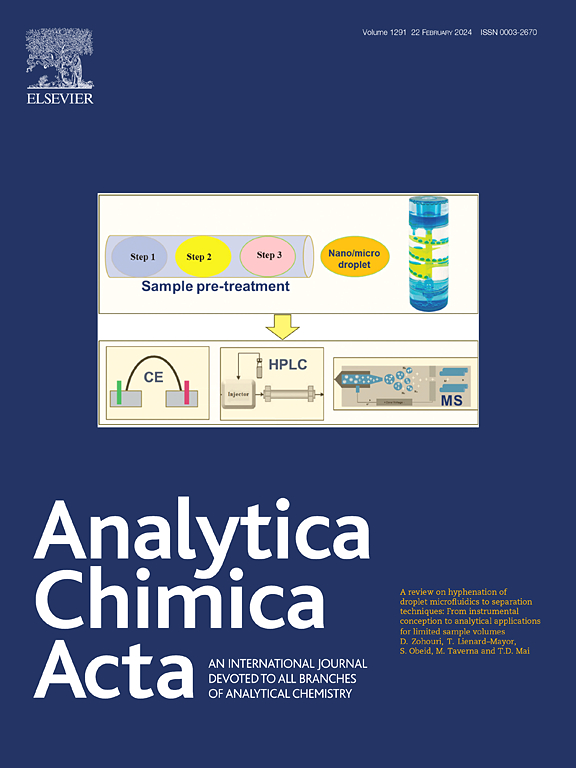基于铌氧化物的电化学生物传感器研究进展
IF 5.7
2区 化学
Q1 CHEMISTRY, ANALYTICAL
引用次数: 0
摘要
背景诊断领域是一个不断扩大的领域,人们一直在寻找替代传统技术的方法。在这种情况下,电化学生物传感器因其低成本、便携性和高灵敏度和特异性而受到关注。在过去的二十年里,含铌氧化物由于其良好的性质,如化学稳定性,良好的生物相容性,以及获得纳米结构形态的可能性,被提出用于构建电化学生物传感器。此外,生物传感器的发展还有其他关键步骤,如表面生物功能化和电化学检测策略。结果综述了含铌氧化物在电化学生物传感器中的应用。从文献中可以观察到,大多数作品忽视了对含铌氧化物的单一作用的阐明,并且缺乏对其优于其他材料的讨论。然而,考虑到这些工作的结果,可以得出结论,含铌氧化物是电化学生物传感器结构的合适候选者。此外,本文还探讨了电极结构,并详细介绍了用于实现静电或共价固定的化学和生物表面功能化技术,特别强调了表面形态结构如何影响生物受体的固定和每种类型的生物传感器的组装。分析了电化学检测策略,重点介绍了它们在不同类型生物传感器中的具体应用。此外,对含铌氧化物在生物传感器结构中的应用前景进行了展望。意义与新颖性本文对电化学生物传感器、纳米材料和诊断领域的研究人员提供了有价值的见解。它提供了一个概述,没有时间限制,知识库有关使用含铌氧化物的电化学生物传感器的发展,重点是合成方法,形态和电极结构,表面生物功能化和电化学检测。本文章由计算机程序翻译,如有差异,请以英文原文为准。

Electrochemical Biosensors Based on Niobium-containing Oxides: A Review
Background
The diagnosis area is an expanding field, and methodological alternatives for the traditional techniques have been sought. In this context, electrochemical biosensors have attracted attention due to their low cost per analysis, portability, and high sensitivity and specificity. Over the past two decades, niobium-containing oxides have been proposed for the construction of electrochemical biosensors due to their favorable properties, such as chemical stability, good biocompatibility, and the possibility of obtaining nanostructured morphologies. Additionally, biosensor development has other critical steps for its success, such as surface biofunctionalization and electrochemical detection strategy.Results
This work provides a concise overview of niobium-containing oxides applied in developing electrochemical biosensors. From the literature, it was possible to observe that most of the works neglect the elucidation of the singular role of niobium-containing oxide and there is a lack of discussion of its advantages over other materials. However, considering the results of the reviewed works, it can be concluded that niobium-containing oxides are a suitable candidate for electrochemical biosensor construction. In addition, this review explores electrode construction and details chemical and biological surface functionalization techniques that are used to achieve electrostatic or covalent immobilization, especially emphasizing how surface morphological structures impact bioreceptor immobilization and the assembly of each type of biosensor. Electrochemical detection strategies are analyzed, focusing on their specific applications in different biosensor types. Besides, future perspectives of niobium-containing oxides applied to biosensor construction are discussed.Significance and Novelty
This review article offers valuable insights for researchers working in the fields of electrochemical biosensors, nanomaterials, and diagnostics. It provides an overview, without time constraints, of the knowledge base regarding the use of niobium-containing oxides for the development of electrochemical biosensors, focusing on synthesis methods, morphology and electrode construction, surface biofunctionalization, and electrochemical detection.求助全文
通过发布文献求助,成功后即可免费获取论文全文。
去求助
来源期刊

Analytica Chimica Acta
化学-分析化学
CiteScore
10.40
自引率
6.50%
发文量
1081
审稿时长
38 days
期刊介绍:
Analytica Chimica Acta has an open access mirror journal Analytica Chimica Acta: X, sharing the same aims and scope, editorial team, submission system and rigorous peer review.
Analytica Chimica Acta provides a forum for the rapid publication of original research, and critical, comprehensive reviews dealing with all aspects of fundamental and applied modern analytical chemistry. The journal welcomes the submission of research papers which report studies concerning the development of new and significant analytical methodologies. In determining the suitability of submitted articles for publication, particular scrutiny will be placed on the degree of novelty and impact of the research and the extent to which it adds to the existing body of knowledge in analytical chemistry.
 求助内容:
求助内容: 应助结果提醒方式:
应助结果提醒方式:


